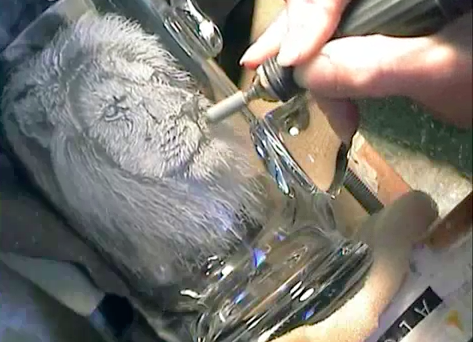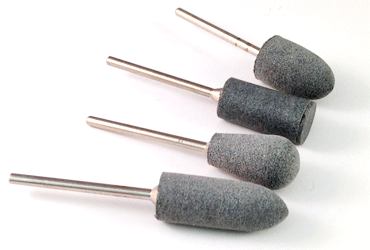You’ve been asking for these for some time now and we’re happy to say, they’ve arrived! We spent a few months getting samples in from various places and testing out the quality and then we came across these little beauties.

Grey Bullet Polisher being used to smooth this glass engraving by Lesley Pyke
So what are they used for, and what’s the big deal? Let’s find out…
What Material can my Grey Rubber Silicone Polishers be Used on?
Taking care to use your tools on the materials they’re intended for is vitality important to ensure your tools have the life span that’s expected of them. As we all know trying to stir a cup of tea with a chocolate teaspoon doesn’t you get you very far and the same applies for your craft tools – use them on the correct materials and you’ll get the results you’re looking for. Here’s what to use your grey rubber polishers on…
- Glass
- Silver
- Platinum
- Gold
- Titanium
- Aluminium
- Enamel
- Steel
- Stainless Steel
- Non-ferrous metals
- Acrylic
- Resin
When Would You Need to Use a Silicon Carbide Rubber Abrasive?
1) When glass engraving, use for smoothing the glass after using your diamond burs, follow up with further grades of silicone polishers
2) Use for smoothing Platinum, Gold, Silver, Titanium jewellery then polish with a finer grit abrasive for a high lustre finish, something such as a rubber wheel polisher in blue then pink or for more intricate metal work such as chains or the inside of rings perhaps try a red, green then fawn rubber pin polisher or a set of radial bristle discs.

Grey Rubber Silicone Polishers for smoothing Glass, Platinum, Gold, Titanium, Silver
How to Use a Grey Rubber Silicone Polisher
- Use on a low speed, not exceeding 7,000RPM
- No compound required, just pop them in your drill and away you go!
What Tools they Are Used In?
- Hand held rotary hobby drill such as a Dremel
- In a micro motor
- In a pendant drill
- By hand
- Held in a pin vise.
So, What’s All The Fuss About?
In your tool kit you’ve probably got a variety of polishing tools that all do the same job but in slightly different ways, why you ask should I buy one more to add to the collection?
There’s a reason why you have so many polishing tools, pastes and equipment, partly because like me you can’t resist trying one more out, but also because although they may look the same, they DO differ in many ways and can change the outcome of the project you’re working on.
What are the benefits over other tools, why is Silicon Carbide so cool?
The shape of the burr, the differing grades of silicone carbon used, the way the abrasive is bonded to the shaft and the ease of use are all factors that can make a huge difference when buying one silicone carbide abrasive over another. Here are some of the advantages:
- Very hard wearing
- Mounted onto a steel shaft of 2.35mm (3/32″)
- Designed to work well under high temperature
- Extremely tough material
What Are They Made Of?
These burrs are made from Silicon Carbide (SiC), also known as carborundum which, obvious as it may sound is a compound of silicon and carbide. Invented by Edward Goodrich Acheson it’s particularly hard wearing and therefore a very durable material and has been an important chemical compound since the late 19th century for use on tools such as grinding wheels, abrasive burrs, cutting tools and sandpapers.
What Are the Technical Specifications?
- Silicon Carbide
- Mounted onto a 2.35mm (3/32″) shaft of steel
- Shapes: Bullet, Flame, Cylinder, Oval and Wheel
- Sizes: Approx 10mm diameter, 20mm length
- Grit size: medium
Here’s a video demonstrating how to use grey rubber polishers to achieve a 3D effect when engraving glass: